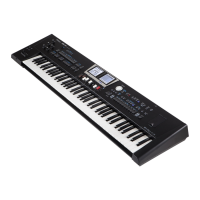Menu options
130
Parameter Setting
Portamento Time 0~127
Bender Assign
This parameter allows you to specify for each keyboard part how it
should respond to Pitch Bend messages.
Parameter Setting
Bender Assign Auto, On, O
• “Auto”: The keyboard part only responds to left/right
movements of the BENDER/MODULATION lever when no
split setting causes it to be to the left of other keyboard parts.
In other words: parts you can play with your left hand after
selecting a split no longer respond to pitch bend messages. But
they will while the keyboard is not split.
• “On”: The keyboard part always responds to left/right
movements of the BENDER/MODULATION lever.
• “O”: The part in question does not respond to left/ right
movements of the BENDER/MODULATION lever.
NOTE
If a SuperNATURAL tone is selected and its “Bend Mode”
parameter is “On”, the “Auto” and “On” value of “Bender Assign”
do not act.
For more information about “Bend Mode” see “SuperNATURAL
Edit (Only if a SuperNATURAL tone is selected)” (p. 131).
Bender Range
This parameter sets the pitch interval, i.e. the value that will be used
when the BENDER/MODULATION lever is pushed all the way to the
left or right.
Parameter Setting
Bender Range 0~+24
NOTE
If a SuperNATURAL tone is selected and its “Bend Mode”
parameter is “On”, the “Bender Range” parameter does not act.
For more information about “Bend Mode” see “SuperNATURAL
Edit (Only if a SuperNATURAL tone is selected)” (p. 131).
Modulation Assign
This parameter allows you to specify for each keyboard part how it
should respond to Modulation messages (CC01).
Parameter Setting
Modulation Assign Auto, On, O
• “Auto”: The keyboard part only responds to backward
movements of the BENDER/MODULATION lever when no
split setting causes it to be to the left of other keyboard parts.
In other words: parts you can play with your left hand after
selecting a split no longer respond to modulation messages. But
they will while the keyboard is not split.
• “On”: The keyboard part always responds to backward
movements of the BENDER/MODULATION lever.
• “O”: The part in question does not respond to backward
movements of the BENDER/MODULATION lever.
Slider CC1, Slider CC2, Slider CC3
You can assign to the Sliders CC1~CC3 a function.
Parameter Setting
Slider CCx
OFF, Cut O, Resonance, Attack, Decay, Release,
Vibrato Rate, Vibrato Depth, Vibrato Delay, C1, SN
Noise*, SN Speed*, SN Growl Sense*,
* For details regarding this settings refer to the“Tone & Drum Kit
List “ supplementary manual.
Download it from the Web http://www.roland.com/manuals/).
Tone Edit (Not for all tone)
NOTE
The Tone Edit function is not applicable to some tones,
SuperNATURAL tones and Harmonic Bar.
Parameter Setting Explanation
Cut O –64~+63
This lter parameter allows you to make the
selected sound darker or brighter. Positive
settings mean that more overtones will be
allowed to pass, so that the sound becomes
brighter. The further this value is set in the
negative direction, the fewer overtones will
be allowed to pass and the sound will become
softer (darker).
Characteristics of a low-pass lter
Setting
Frequency
Cuto frequency
NOTE
For some sounds, positive (+) Cuto settings
will cause no noticeable change because
the pre-programmed Cuto parameter is
already set to its maximum value
Resonance –64~+63
When the Resonance value is increased, the
overtones in the area of the cuto frequency
will be emphasized, creating a sound with a
strong character.
NOTE
For some sounds, negative (–) “Resonance”
settings may produce no noticeable change
because the Resonance is already set to the
minimum value.
Attack –64~+63
This parameter adjusts the onset of the sound.
Negative values speed up the attack, so that
the sound becomes more aggressive.
Decay –64~+63
This parameter adjusts the time over which
the sound’s volume and cuto frequency fall
from the highest point of the attack down to
the sustain level.
NOTE
Percussive sounds usually have a sustain
level of “0”. Piano and guitar sounds are in
this category. Holding the keys for a long
time will have little eect on the duration of
the notes you are playing, even if you select
a high value here
Release –64~+63
This parameter adjusts the time over which
the sound will decay after the note is
released until it is no longer heard. The cuto
frequency will also fall according to this
setting.
Vibrato Rate –64~+63
This parameter adjusts the speed of the pitch
modulation. Positive (+) settings make the
preset pitch modulation faster and negative
(–) settings make it slower.
Vibrato Depth –64~+63
This parameter adjusts the intensity of the
pitch modulation. Positive (+) settings mean
that the “wobble” becomes more prominent,
while negative (–) settings make it shallower.
Vibrato Delay –64~+63
This parameter adjusts the time required
for the vibrato eect to begin. Positive (+)
settings increase the time before vibrato will
begin and negative settings shorten the time

